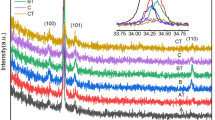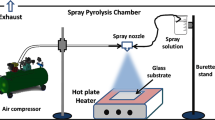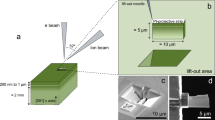Abstract
GaAs lattice “superdilation” caused by an introduced tellurium impurity, which is well known in publications, is experimentally studied. This phenomenon consists in the fact that the GaAs-lattice dilation can be more than 10 times greater than expansion that would appear upon the replacement of arsenic atoms with tellurium atoms if calculations are performed using the current-carrier concentration and Vegard’s law. The given phenomenon has already been observed at n Te > 3 × 1018 cm–3. A series of GaAs epitaxial layers heavily doped with tellurium and grown via metal-organic chemical vapor deposition are investigated using high-resolution X-ray diffractometry (HRXRD), secondary-ion mass spectrometry (SIMS), and the Hall effect. It is demonstrated that, despite a high Te concentration (1020‒1021 cm–3) in the layer and variations in the growth conditions, the concentration estimates based on HRXRD data depend linearly on the results of elemental analysis performed by means of SIMS. The GaAs lattice expands even somewhat slighter as compared to the case where arsenic atoms are replaced with all Te atoms injected into the layer. At the same time, the Hall carrier concentration decreases sharply beginning at 2 × 1020 cm–3. In accordance with the obtained results, the examined phenomenon can be interpreted as the strong compensation of donor and acceptor carriers rather than as superdilation.
Similar content being viewed by others
References
P. F. Fewster, X-Ray Scattering from Semiconductors (Imperial College Press, London, 2000).
D. K. Bowen and B. K. Tanner, High Resolution X-ray Diffractometry and Topography (Taylor & Francis, London, 1998).
J. Singh, Electronic and Optoelectronic Properties of Semiconductor Structures (Cambridge Univ. Press, Cambridge, 2003).
C. Giannini, C. Gerardi, L. Tapfer, A. Fischer, and K. H. Ploog, J. Appl. Phys. 74, 77 (1993).
Yu. N. Drozdov and P. A. Yunin, J. Surf. Invest.: X-ray, Synchrotron Neutron Tech. 9 (6), 1243 (2015).
Yu. N. Drozdov and P. A. Yunin, J. Surf. Invest.: X-ray, Synchrotron Neutron Tech. 10 (1), 96 (2016).
Yu. N. Drozdov, M. N. Drozdov, V. M. Daniltsev, O. I. Khrikin, and P. A. Yunin, Semiconductors 46 (11), 1392 (2012).
G. M. Kuznetsov, O. V. Pelevin, A. D. Barsukov, V. V. Olenin, and I. A. Savel’eva, Kristallografiya 17, 539 (1972).
J. B. Mullin, B. W. Straughan, C. M. H. Driscoll, and A. F. W. Willoughby, J. Appl. Phys. 47, 2584 (1976).
G. G. Burlaku, M. M. Markus, and V. G. Tirzin, Izv. Akad. Nauk SSSR, Ser. Neorg. Mater. 13, 820 (1977).
A. G. Milnes, in Advances in Electronics and Electron Physics, Ed. by P. W. Hawkes (Academic Press, New York, 1983), Vol. 61, p.63.
E. G. Seebauer and M. C. Kratzer, Charged Semiconductor Defects: Structure, Thermodynamics and Diffusion (Springer, London, 2009).
D. T. J. Hurke, J. Appl. Phys. 85, 6957 (1999).
D. T. J. Hurke, J. Appl. Phys. 107, 121301 (2010).
B. Paquette, B. Ilahi, V. Aimez, and R. Arès, J. Cryst. Growth 383, 30 (2013).
B. Galiana, I. Rey-Stolle, C. Algora, and I. Garcia, J. Appl. Phys. 104, 114906 (2008).
M. Kamp, G. Mörsch, J. Gräber, and H. Lüth, J. Appl. Phys. 76, 1974 (1994).
B. K. Vainshtein, V. M. Fridkin, and V. L. Indenbom, Modern Crystallography, Vol. 2: Crystals’ Structure (Nauka, Moscow, 1979) [in Russian].
O. Madelung, Semiconductors: Data Handbook (Springer, New York, 2003).
M. Leszczynski, E. Litvin-Staszewska, and T. Suski, Acta Phys. Pol., A 88 (5), 837 (1995).
Author information
Authors and Affiliations
Corresponding author
Additional information
Original Russian Text © Yu.N. Drozdov, V.M. Danil’tsev, M.N. Drozdov, P.A. Yunin, E.V. Demidov, P.I. Folomin, A.B. Gritsenko, S.A. Korolev, E.A. Surovegina, 2017, published in Poverkhnost’, 2017, No. 3, pp. 89–94. Investigation
Rights and permissions
About this article
Cite this article
Drozdov, Y.N., Danil’tsev, V.M., Drozdov, M.N. et al. Investigation of X-ray diffraction limitations upon the analysis of tellurium-atom injection into GaAs epitaxial layers. J. Surf. Investig. 11, 361–365 (2017). https://doi.org/10.1134/S1027451017020069
Received:
Published:
Issue Date:
DOI: https://doi.org/10.1134/S1027451017020069




